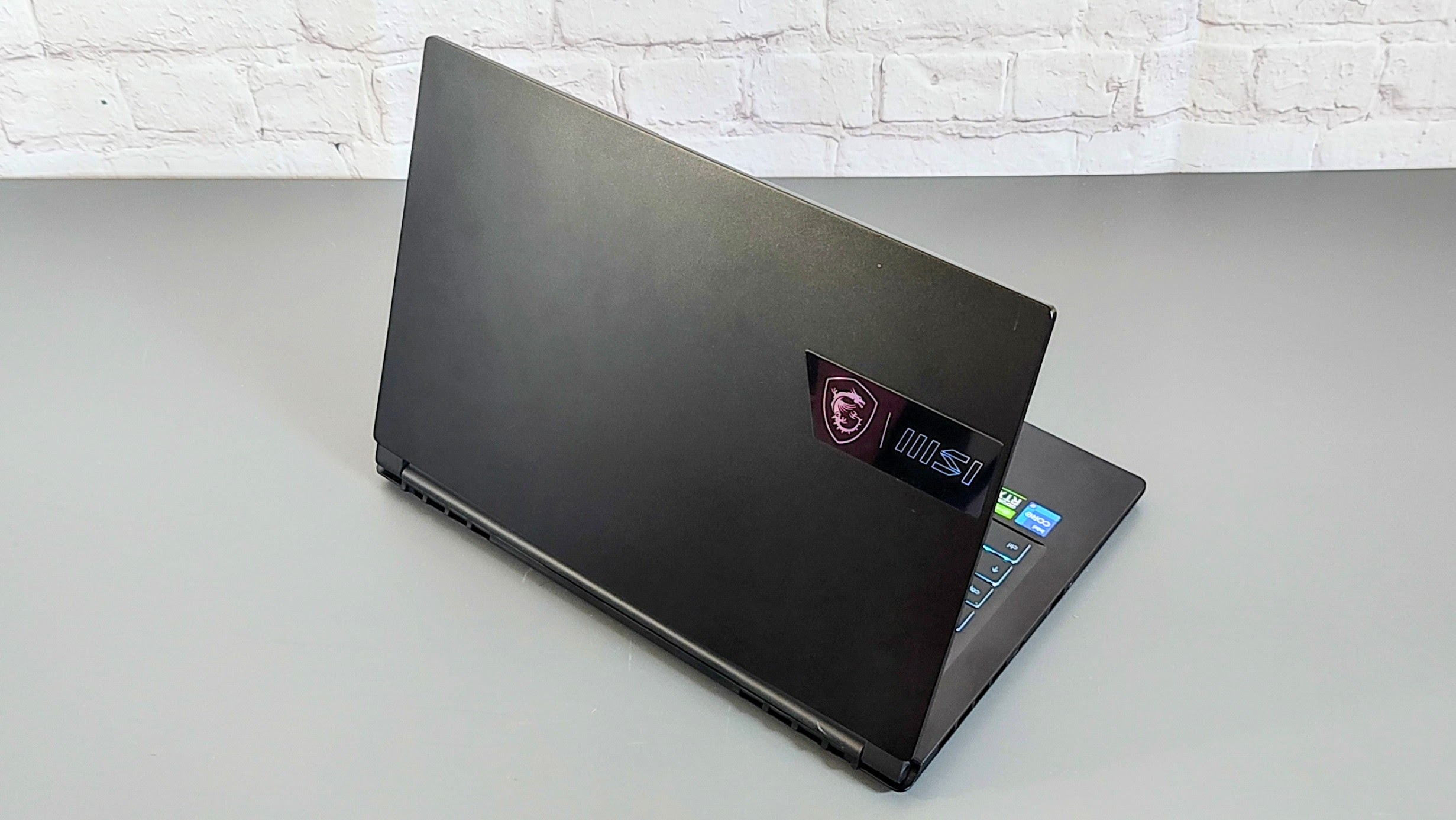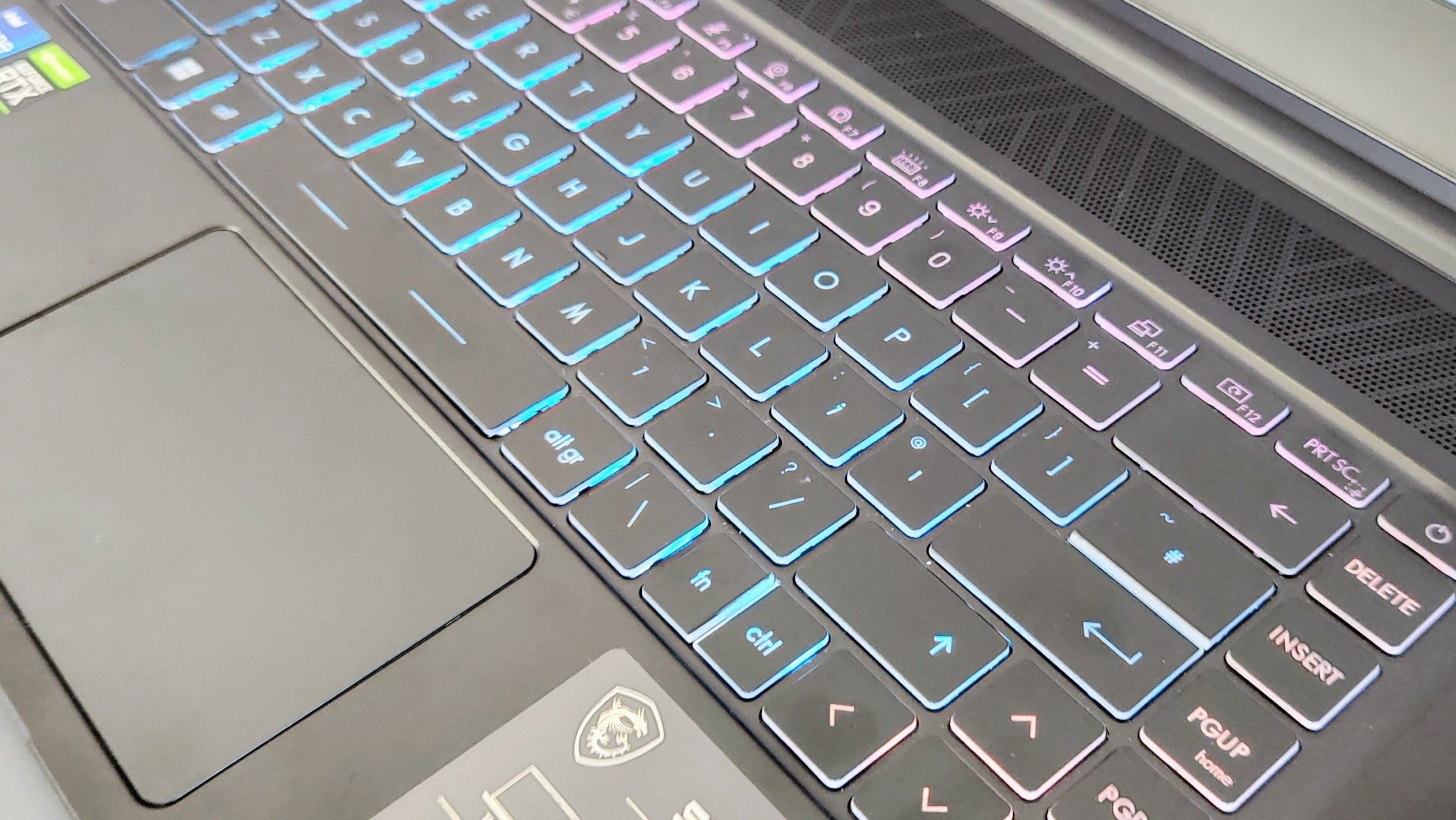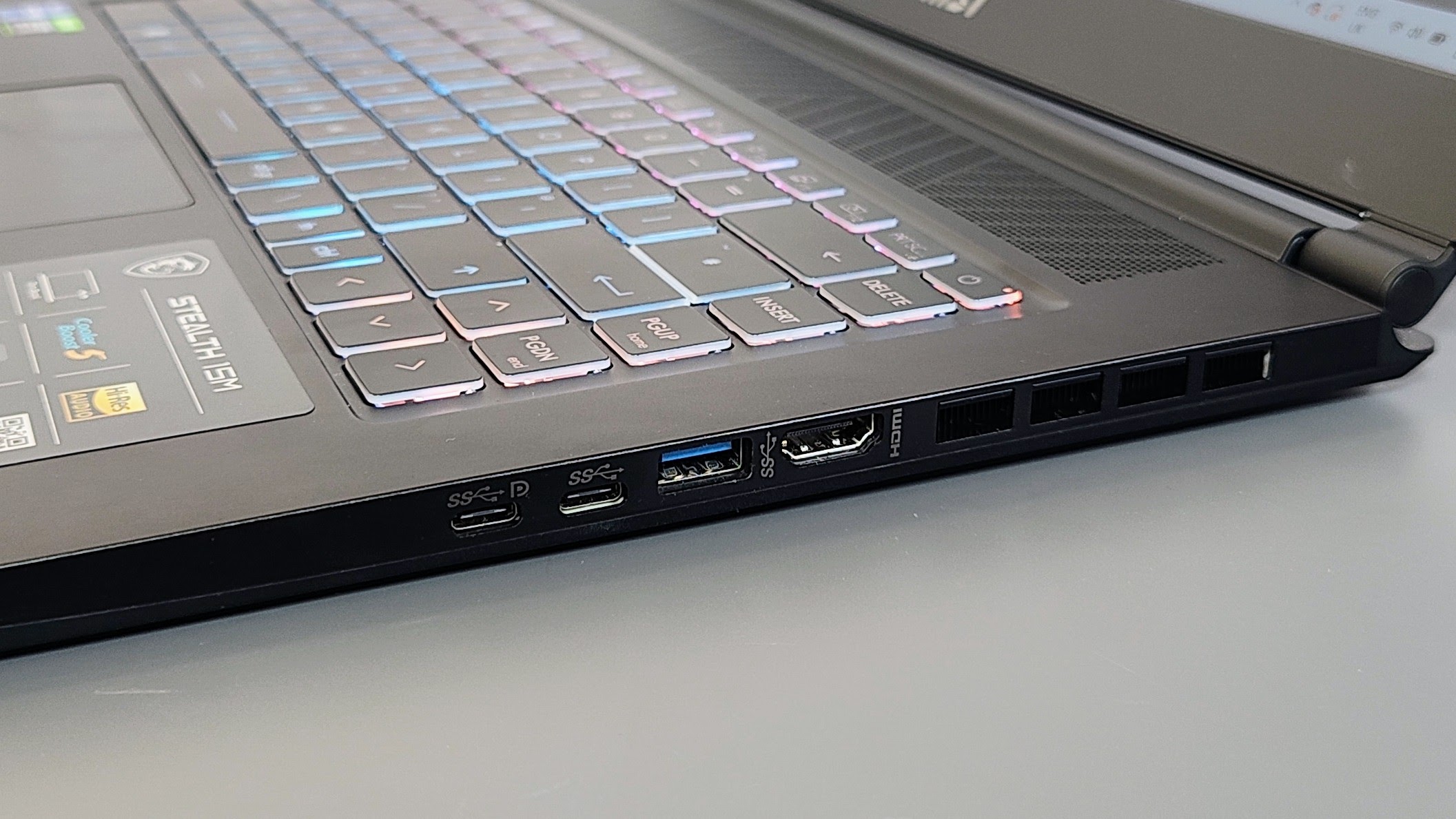MSI Stealth 15M review: A potent but somewhat flawed ultrabook
Great in parts, frustrating in others but this MSI Stealth 15M is still a worthwhile choice if the price is right

-
+
A lot of performance for the money
-
+
Stylish, light and compact
-
+
Good keyboard
-
-
Dire battery life
-
-
No space for a second SSD
-
-
Drab display

When MSI released its take on the gaming ultrabook, the Stealth M15, midway through 2022 it was rather expensive not leaving you with much if any change from £1,500. But now with Raptor Lake processors and RTX 40 GPUs imminent you can pick it up for around two-thirds of that which begs the question: Does that make it a good buy for someone who wants a light and compact notebook but one with a powerful discrete GPU and fast refreshing display?
MSI Stealth 15M review: Design
There can be no doubt that the Stealth M15 does a good job of hiding its powerful innards. Weighing in at just 1.8Kg and measuring up at 358 x 248 x 17mm you would be forgiven for thinking it's just a humdrum laptop and not one packing a high-performance discrete GPU.
For comparison that makes the 15M much the same size and weight as the Razer Blade 14 which is generally regarded as the doyen of gaming ultrabooks but is a machine with a significantly higher price tag and a smaller 14in display.
The body of the 15M is an angular black affair made largely from aluminium and it both looks and feels like a high-quality and durable item but my oh my does it show greasy fingerprints. The lid is fairly rigid and it folds back 180 degrees. As with many MSI laptops, the F12 key flips the display so you can show whatever is on it to someone sitting across the table from you.
After removing the base panel we were a little disappointed to discover that there is no option to add a second SSD even though there is quite clearly more than enough room. Upgrading the two RAM modules involves removing the motherboard which strikes us as another rather poor design choice.
MSI Stealth 15M review: Keyboard & touchpad
The keyboard is a solid and spacious affair with a full-sized cursor and Page Up / Down keys. The keys themselves have a perfectly damped and firm action which combines with 1.5mm of travel to make typing on the M15 a thoroughly pleasant undertaking. There's no numeric keypad but they are hardly a given on 15in laptops so there's no reason to slam the 15M for the lack.

The backlight is what MSI calls a Spectrum affair which means you get three fixed lighting zones, blue for the QWERTY part, pink for the number and function keys and orange for the navigation and ancillary keys on the far right.
Unlike many of MSI's hardcore gaming laptops, the 15M doesn't come with a SteelSeries control panel so you can't change any of the colours or add macros but you can adjust the intensity of the backlight in three stages. The elegant keycap graphics and translucent sides to the keys make the whole assembly very attractive and not too garish for a work environment.
The touchpad is rather small by modern standards at just 105 x 65mm but it is perfectly smooth to the touch (MSI doesn't say what the touchpad is made from but we'd say it was glass if asked) and the click-action is clean and precise and not too loud.
MSI Stealth 15M review: Specs and performance
The Stealth 15M packs a 14-core 12th generation Intel Core i7-1280P processor, an Nvidia RTX3060 GPU with 6GB of vRAM and a TGP of 75W. There is also 16GB of dual-channel DDR4 RAM. That's a combination that gives the MSI a serious turn of speed.
In the IT Pro 4K multi-media benchmark the Stealth 15m scored 343 points which is a figure you'll only find bettered in a meaningful way by laptops running an Nvidia RTX3080 or equivalent AMD dGPU with a much higher TGP. The 15M's score was a significant 64 points higher than it's stable mate, the MSI Prestige 15, scored with the same processor but an RTX3050 GPU with a 40W TGP.
The 15M's GeekBench 5 scores of 10,797 (single-core) and 94,260 (multi-core) are adrift of what you would expect from an Intel H-series Core i7 chip like the 12700H or 12900H but they are the highest we've seen from a P-series Alder Lake processor which underscores the 15M's performance levels.
Clearly the RTX3060 GPU inside the Stealth can't match the sort of speeds we saw from the mighty MSI Creator Z17 with its RTX3080Ti GPU (which also has 16GB of vRAM to the 15M's 6GB) but the SPECviewperf 3dsmax 3D modelling test still ran at a respectable 67.5fs compared to the Z17's 129fs. To get a handle on the 15M's gaming credentials we ran the Metro Exodus benchmark in the lowest – counterintuitively labelled High – detail setting with DLSS set to Balanced and got a creditable result of 78.5fs.
MSI has done a good job with the cooling system of the Stealth 15M. The grill above the keyboard (which most people mistake for a speaker array cover when they are in fact buried in the front corners of the chassis) does get rather hot during prolonged high-demand runs but at no point is the CPU or GPU subject to any thermal throttling.
MSI Stealth 15M review: Display
Sadly the 1,920 x 1,080 IPS display is not an asset to the 15M. Maximum brightness and contrast ratio are good enough at 280cd/m2 and 1147:1 respectively (the last helped by an impressively low black luminance of just 0.21cd/m2) but colour gamut support is very narrow, measuring just 54.6% sRGB and less than 40% DCI-P3 and Adobe RGB. Colour accuracy is seriously out of whack too with a Delta E variance of 8.13 against the sRGB profile.

For basic productivity work none of this is too much of a problem and with a 144Hz refresh rate everything looks smooth as can be but videos and photographs look drab and washed out and any sort of work that requires colour accuracy is clearly out of the question given the high Delta E variance.
In a purebred gaming notebook, those failings would be easier to excuse but in a machine designed for a more varied life, we think there are a bit of a problem.
MSI Stealth 15M review: Battery life
Diabolical is the only word we can use here. In our battery rundown test where we loop a standard definition video in VLC with the screen brightness dialled down to 25% in Airplane Mode the 15M lasted just 3 hours and 50 minutes. For fun, we moved the system setting from Balanced to Performance and looped a gaming benchmark. That drained the battery in 50 minutes and no, we haven't missed an hour number before that.
As with the screen quality such numbers are parr for the course with gaming notebooks but the assumption must be that the 15M will be used away from a power source more often than a dedicated gamer and for that, a 53.8Wh battery simply is not enough.
MSI Stealth 15M review: Ports and features
The 15M is fairly well arrayed with I/O ports. On the right, you will find two USB Type-C 3.2 Gen 2 ports, an HDMI 2.0 video output and a USB Type-A 3.2 Gen 1 port. On the left is another Type-A, a 3.5mm audio jack and a DC-in jack which means you don't lose a Type-C to charging. Only one of the Type-Cs supports DisplayPort 1.4 video output.
A lot of dedicated gaming laptops don't have webcams and of those that do, the quality is usually rather poor. The Stealth 15M falls into the latter category with a very workaday 720p camera that is both drab and visually quite noisy. There's no support for Windows Hello facial recognition nor is there a fingerprint scanner meaning you will be forced to resort to a password or PIN for user security.

Turning to the Stealth 15M's other internal components the 1TB Micron SSD proved to be a good performer completing sequential read and write tests at 3,023MB/s and 2,917MB/s respectively and 4K read and writes at an even more impressive 84.2MB/s and 296.1MB/s.
Wireless communications are handled by an Intel AX201 card that only supports 2.4GHz and 5GHz Wi-Fi and not the latest 6GHz spectrum.
A final bug rather than a feature is MSI's insistence on pinning the XBox app icon to the taskbar. To permanently remove it you need to dig around in Windows and find the LayoutModification.xml file and modify it accordingly.
MSI Stealth 15M review: Verdict
For under £1,000 the MSI Stealth 15M delivers some very serious performance all wrapped up in a light and compact chassis with a rather fine keyboard. In the negative column, the battery run time is truly abysmal and the screen while fast, is dull and drab.
The speaker system meanwhile is merely average, neither a strength nor a weakness.
If you regularly use your laptop away from a power supply then this MSI is a non-starter, similarly, if you want to do any work that requires a colourful and colour-accurate display the Stealth 15M is again not for you. On the other hand, if you want a laptop for portability rather than mobility, and want something to run graphics jobs or games fast, then the Stealth 15M could be an affordable answer to your problem.
MSI Stealth 15M Specifications
| Processor | Intel Core i7-1280P |
| RAM | 16GB dual-channel |
| Graphics adapter | Nvidia RTX3060 |
| Storage | 1TB |
| Screen size (in) | 15.6 |
| Screen resolution | 1920 x 1080, 144Hz |
| Screen type | IPS |
| Touch screen | No |
| Memory card slot | No |
| 3.5mm audio jack | Yes |
| Graphics outputs | HDMI 2.0 x 1, DisplayPort 1.4 x 1 |
| Other ports | USB Type-C x 2, USB-A 3.2 Gen 1 x 2 |
| Webcam | 720p |
| Speakers | Stereo |
| Wi-Fi | Wi-Fi 6 (802.11ac) |
| Bluetooth | 5.2 |
| Operating system | Windows 11 Home |
| Dimensions (WDH) | 358 x 248 x 17mm |
| Weight (Kg) | 1.8Kg |
| Battery capacity (Wh) | 54Wh |
Get the ITPro daily newsletter
Sign up today and you will receive a free copy of our Future Focus 2025 report - the leading guidance on AI, cybersecurity and other IT challenges as per 700+ senior executives
Over the years, Alun has written freelance for several online publications on subjects ranging from mobile phones to digital audio equipment and PCs and from electric cars to industrial heritage. Before becoming a technology writer, he worked at Sony Music for 15 years. Quite what either occupation has to do with the degree in Early Medieval History he read at the University of Leeds is a bit of a grey area. A native of Scotland but an adopted Mancunian, Alun divides his time between writing, listening to live music, dreaming of the glens and dealing with an unhinged Norwegian Elkhound. For ITPro, Alun reviews laptops and PCs from brands such as Acer, Asus, Lenovo, Dell and HP.
-
 ‘Phishing kits are a force multiplier': Cheap cyber crime kits can be bought on the dark web for less than $25 – and experts warn it’s lowering the barrier of entry for amateur hackers
‘Phishing kits are a force multiplier': Cheap cyber crime kits can be bought on the dark web for less than $25 – and experts warn it’s lowering the barrier of entry for amateur hackersNews Research from NordVPN shows phishing kits are now widely available on the dark web and via messaging apps like Telegram, and are often selling for less than $25.
By Emma Woollacott Published
-
 Redis unveils new tools for developers working on AI applications
Redis unveils new tools for developers working on AI applicationsNews Redis has announced new tools aimed at making it easier for AI developers to build applications and optimize large language model (LLM) outputs.
By Ross Kelly Published
-
 Google layoffs continue with "hundreds" cut from Chrome, Android, and Pixel teams
Google layoffs continue with "hundreds" cut from Chrome, Android, and Pixel teamsNews The tech giant's efficiency drive enters a third year with devices teams the latest target
By Bobby Hellard Published